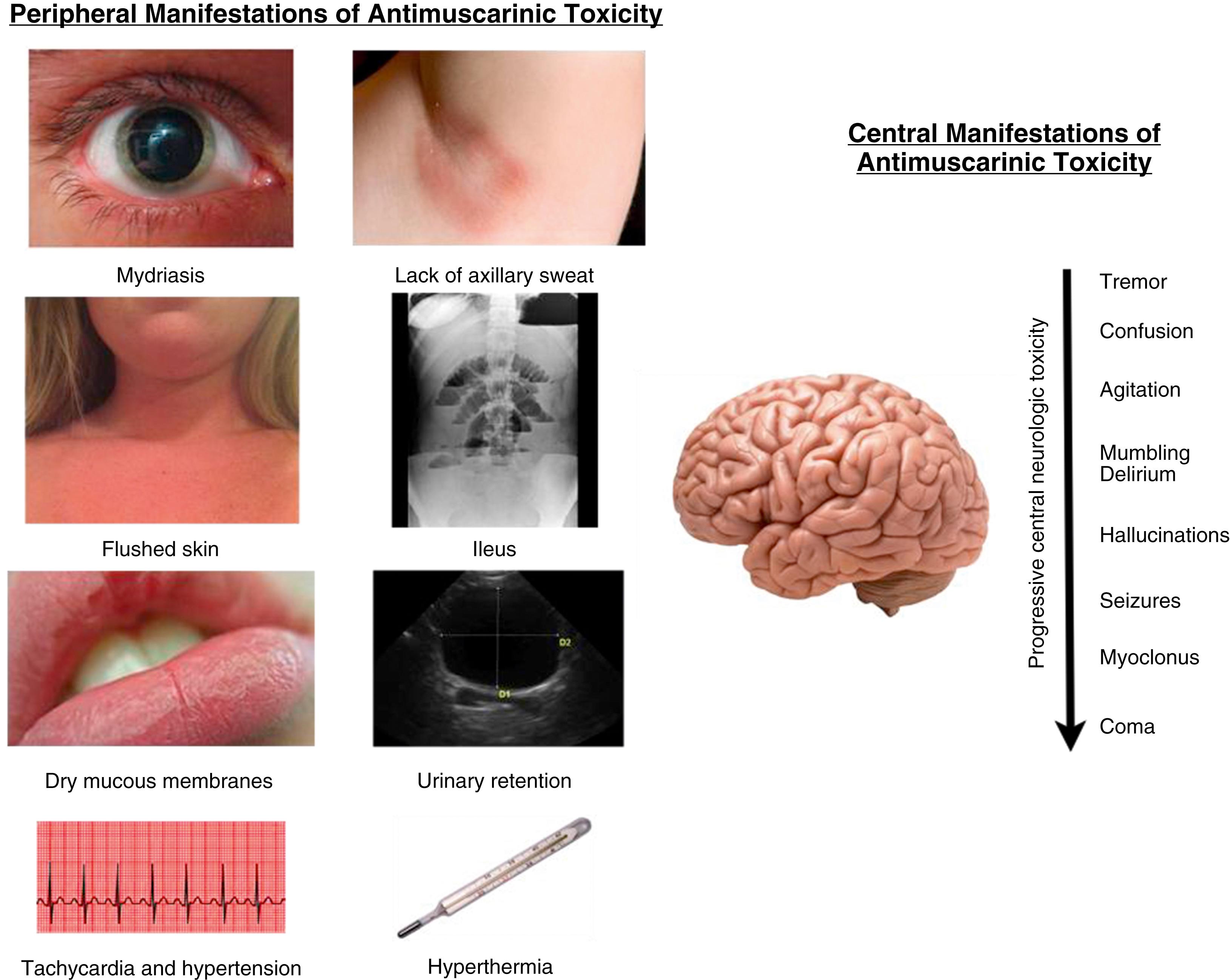Physical Address
304 North Cardinal St.
Dorchester Center, MA 02124
Anticholinergic (antimuscarinic) intoxication is common and can occur as a result of ingestion of a variety of plants and drugs, both prescription and over-the-counter.
Most patients with antimuscarinic toxicity do well with supportive care and observation.
Antimuscarinic syndrome varies in clinical presentation with either peripheral or central manifestations predominating.
Central antimuscarinic delirium is most effectively treated with physostigmine.
Contraindications to physostigmine administration include narrow angle glaucoma, atrioventricular (AV) blockade, bradycardia, and seizure precipitated by overdose.
Anticholinergic agents cause toxicity through inhibition of muscarinic, nicotinic, parasympathetic, or sympathetic acetylcholine receptors. Nicotinic receptor inhibition and ganglionic acetylcholine inhibition at parasympathetic and sympathetic locations are covered in Chapter 152 . This chapter will focus on antimuscarinic effects and toxicity. The terms anticholinergic and antimuscarinic are used synonymously though the mechanism of toxicity is more accurately described by the term “antimuscarinic,” and thus that term will be used in this chapter.
Antimuscarinic effects are due to competitive inhibition of acetylcholine at muscarinic receptors. Muscarinic receptors are found on peripheral postganglionic cholinergic nerves in smooth muscle (intestinal, bronchial, and cardiac), the secretory glands (salivary and sweat), the ciliary body of the eye, and the central nervous system (CNS).
Antimuscarinic agents have been used medicinally from antiquity to the present day. Mandrake plant remains were found in the coffin of Tutankhamen, the Old Testament of the Bible references its use as an aphrodisiac, and antimuscarinic plants were used as anesthetics in Greek and Roman settlements in the 1st century. Atropine, hyoscyamine, and scopolamine are naturally occurring tertiary amine antimuscarinic agents that remain in wide clinical use today. The tertiary amine structure allows the agent to cross the blood-brain barrier; therefore, these agents may precipitate CNS toxicity. Quaternary amine antimuscarinic agents, such as the anti-sialagogue glycopyrrolate, have been developed to mitigate CNS side effects due to their limited ability to cross the blood-brain barrier, though mild delirium may occur in the setting of a large overdose.
Over 600 compounds contain antimuscarinic activity, including prescription drugs, over-the-counter drugs, and plants. The effects of muscarinic receptor blockade are utilized for clinical purposes including pupillary dilation, antispasmodics, sleep aids, treatment of motion sickness, allergic reactions, drying of airway secretions, reactive airway disease, treatment of bradycardia, treatment of Parkinsonism, and the management of urinary incontinence and bladder spasm. The agents that most commonly precipitate antimuscarinic toxicity, such as H1 antihistamines and some antipsychotics, often affect several neurotransmitters and receptor systems in addition to antagonism at muscarinic receptors. This may complicate the clinical presentation and some clinical symptoms may be unique to the specific etiologic agent ( Box 140.1 ).
Mydriasis: “blind as a bat”
Altered mental status: “mad as a hatter”
Dry mucous membranes: “dry as a bone”
Dry, flushed skin: “red as a beet”
Hyperthermia: “hot as hades”
Urinary retention: “full as a flask”
Decreased bowel sounds/ileus
Tachycardia
Antimuscarinic toxicity has both central and peripheral manifestations ( Fig. 140.1 ). Peripheral muscarinic antagonism causes tachycardia, hypertension, hyperthermia, mydriasis, dry mouth, lack of sweating, skin flushing, decreased bowel motility, and urinary retention. Central nervous system blockade of muscarinic receptors may produce delirium characterized by confusion, mumbling speech, agitation, hallucinations, hand picking gestures, myoclonus, tremor, and coma. Manifestations of the toxidrome are frequently incomplete and either peripheral or central components may predominate depending upon which antimuscarinic agent is involved, the dose, and the individual patient ( Table 140.1 ). In one large series of antimuscarinic poisoning, only 28% of patients had all three classic manifestations of tachycardia, dry skin/axilla, and mydriasis. Therefore, most patients will not present with all of these features. Duration of toxicity may be prolonged (18–72 hours) depending on the specific agent, dose, and the pharmacologic effect of delayed gastric emptying.

| Antimuscarinic Agent | Toxic Dose | Unique Clinical Manifestations and Receptors Antagonized. |
|---|---|---|
| Datura spp . | Seeds contain high concentrations of hyoscyamine and scopolamine. The toxic dose depends upon the species and the mode of ingestion. In general 5 to 10 seeds may be toxic. | Classic peripheral and central antimuscarinic features M 1 |
| Diphenhydramine | 2.5 mg/kg, >10 mg/kg may result in cardiovascular and neurologic toxicity | CNS depression, QRS prolongation and ventricular dysrhythmias, seizures M 1, H 1, Na + channels |
| Doxylamine | >20 mg/kg associated with rhabdomyolysis | CNS depression, seizures, rhabdomyolysis M 1, H 1 |
| Tricyclic antidepressants (TCA) | 2.5 mg/kg, >10 mg/kg may result in cardiovascular and neurologic toxicity. | CNS depression, QRS prolongation, ventricular dysrhythmias, seizures, hypotension, antimuscarinic symptoms may manifest late in the course. M 1, H 1, α 1, Na + channels |
| Atypical antipsychotics | Varies depending upon agent. | CNS depression, hypotension, antimuscarinic symptoms may manifest late in the course. M 1 , H 1 , α 1 , D 2, 5-HT 2A |
The differential diagnosis of altered mental status is broad. Consider antimuscarinic toxicity when there is a history of exposure or if there are physical exam findings consistent with the antimuscarinic toxidrome ( Box 140.2 ).
Sympathomimetic toxicity
Serotonin toxicity
Neuroleptic malignant syndrome
Lithium toxicity
Antidepressant toxicity
Antipsychotic toxicity
Intracranial hemorrhage
Seizure
Infectious
Sepsis
CNS infections
Become a Clinical Tree membership for Full access and enjoy Unlimited articles
If you are a member. Log in here